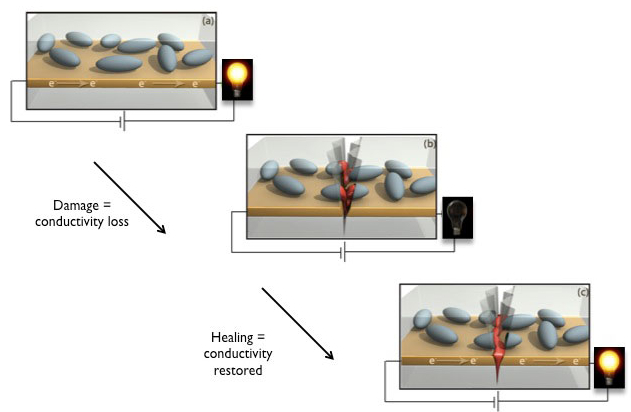Self-healing electronics on liquid capsule regimen

The Achilles' heel of electronics today is that when one tiny circuit failure occurs within an integrated chip, it spells disaster for the whole chip or even the whole device.
To help avoid such losses, engineers at University of Illinois have developed an autonomous restorative circuit system that could fix itself rapidly enough so that the user is oblivious to the failure.
The system, described in the journal Advanced Materials, uses tiny microcapsules as small as 10 microns in diameter and filled with gallium-indium liquid metal; the capsules are dispersed on top of a gold line functioning as a circuit. As a crack propagates, the microcapsules break open and release the metallic liquid into the gaps in the circuit, restoring electrical flow after a period of downtime lasting a few microseconds.

?Self-healing electronics. Microcapsules full of liquid metal sit atop a gold circuit. (Top) When the circuit is broken, the microcapsules rupture (center), filling in the crack and restoring the circuit (bottom). Credit: Scott White
“It simplifies the system,” said chemistry professor Jeffrey Moore, a co-author of the paper. “Rather than having to build in redundancies or to build in a sensory diagnostics system, this material is designed to take care of the problem itself.”
The researchers demonstrated that 90 percent of their samples healed to 99 percent of original conductivity, even with a small amount of microcapsules.
In addition to being autonomous, the self-healing system is also localized, meaning that only the microcapsules that a crack intercepts are opened, so repair only takes place at the point of damage.
The engineers also point out that because the system requires no human intervention or diagnostics, it is especially well-suited for applications where accessing a break for repair is impossible, such as a battery; or when finding the source of a failure is difficult, such as an aircraft or spacecraft.
"In an aircraft, especially a defense-based aircraft, there are miles and miles of conductive wire,” said professor Nancy Sottos. “You don’t often know where the break occurs. The autonomous part is nice -- it knows where it broke, even if we don’t."
The Illinois research team plans to further develop the technology to improve the safety and longevity of batteries, as well as explore other possibilities for using microcapsules to control conductivity.
In the video below, Scott White, an aerospace engineering professor and the project leader, describes the approach:
Source: Illinois News Bureau